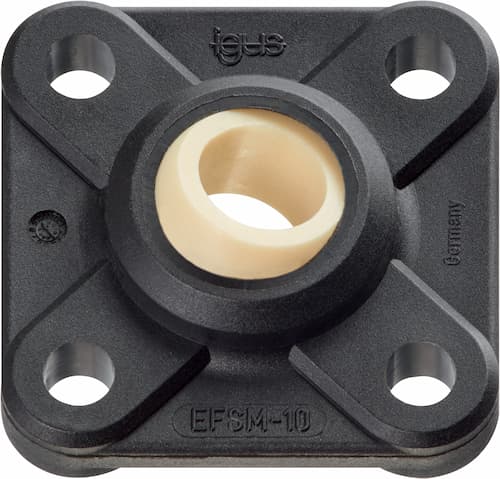
For more information about igubal® spherical bearings, visit www.igus.co.uk/igubal
What material are the igubal® spherical bearings made of?
There is a range of materials that the igubal® range can be made of so it depends on the application. The standard housing is igumid G and the balls tend to be iglidur® J or W300. However there are a large range of materials available.
Are igubal® spherical bearings capable of withstanding the same pressures as a metal version?
This depends on the application however, they have a high tensile strength and can take on high radial loads.
Can I get large/bespoke bearing sizes that are not in the catalogue?
Yes, bespoke sizes can be machined from our plastic rods or plates. The customer would need to supply a drawing of this. Find out more here.
Why is the tilting angle of a K design range bigger than the E design range?
Despite the housing design of the E range being narrower, the ball design in the K range is wider which enables a larger tilting angle.
Is 50mm the largest igubal® bearing size?
As standard it is. We can make bespoke ones on request. Find out more about possibilities of custom parts here.
Why is there such a variation in the movement of the balls?
The variation of the movement is down to the production process:
Clips- These balls added with a clip in process. This is cheaper and we can offer a variation of ball materials.
Overmolding- This process means the balls are soaked, over moulded and then dried. Sometimes the balls are not completely round at the time of the drying process as this is hard to control. Only W300 is over moulded, limiting the ball selection.
Why do igubal® rod ends break?
The weakest part of a rod end is not the thread as long as it has been screwed in sufficiently. We tend to find that if the rod ends break it is at the 10 o’clock position.
If I am using the bearings axially, how can I secure the shaft?
There are various possible ways of securing them:
- A circlip ring- you will need to add a groove into the shaft.
- A fixing collar- this will need to be screwed onto the shaft.
- Add a shoulder onto the shaft. i.e the shafts has a smaller diameter at the ends and cannot slip out of the bearings.
What is the difference between oscillating and tilting angles in igubal®?
An oscillating movement is like a swinging action. A tilting movement is a pivot movement at an angle.
Find out more here.
What ball materials are there?
Currently, stainless steel and aluminium.
Are they available in left and right hand threads?
Absolutely. Find out more here.





